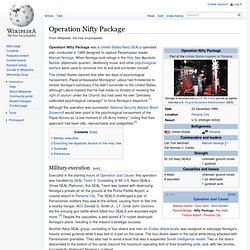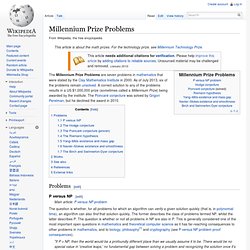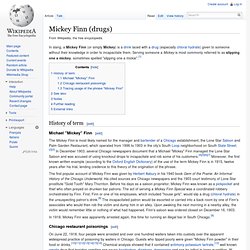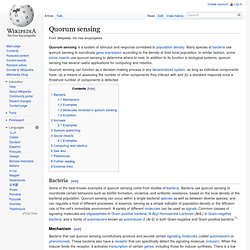

'Sexual depravity' of penguins that Antarctic scientist dared not reveal. It was the sight of a young male Adélie penguin attempting to have sex with a dead female that particularly unnerved George Murray Levick, a scientist with the 1910-13 Scott Antarctic Expedition.

No such observation had ever been recorded before, as far as he knew, and Levick, a typical Edwardian Englishman, was horrified. Blizzards and freezing cold were one thing.
Language. Celtiberia. Operation Nifty Package. Operation Nifty Package was a United States Navy SEALs-operated plan conducted in 1989 designed to capture Panamanian leader Manuel Noriega.

When Noriega took refuge in the Holy See Apostolic Nuncio (diplomatic quarter), deafening music and other psychological warfare were used to convince him to exit and surrender himself. The United States claimed that after ten days of psychological harassment, Papal ambassador Monsignor Laboa had threatened to revoke Noriega's sanctuary if he didn't surrender to the United States, although Laboa insisted that he had made no threats of revoking the right of asylum under the Church, but had used his own "precisely calibrated psychological campaign" to force Noriega's departure.[1] Military execution[edit]
Dokkōdō. The "Dokkōdō" [ (Japanese: 独行道?)

; "The Path of Aloneness", "The Way to Go Forth Alone", or "The Way of Walking Alone"] is a short work written by Miyamoto Musashi (宮本 武蔵) a week before he died in 1645. It consists of either nineteen or twenty-one precepts; precepts 4 and 20 are omitted from the former version. Millennium Prize Problems. The Millennium Prize Problems are seven problems in mathematics that were stated by the Clay Mathematics Institute in 2000.

As of July 2013, six of the problems remain unsolved. A correct solution to any of the problems results in a US $1,000,000 prize (sometimes called a Millennium Prize) being awarded by the institute. The Poincaré conjecture was solved by Grigori Perelman, but he declined the award in 2010. Problems[edit] P versus NP[edit] Divine (actor) Although Divine died in Los Angeles, California from cardiomegaly in 1988, he has remained a cult figure ever since, particularly within the LGBT community, and has provided the inspiration for fictional characters, artworks and songs. Various books and documentary films devoted to his life have also been produced, including Divine Trash (1998) and I Am Divine (2013). Glenn "Divine" Milstead's high school yearbook photo at age 17 Harris Glenn Milstead was born on October 19, 1945, at the Women's Hospital in Baltimore, Maryland.
His father, Harris Bernard Milstead (May 1, 1917 – March 4, 1993), after whom he was named, had been one of seven children born in Towson, Maryland to a plumber who worked for the Baltimore City Water Department. Divine's mother, Frances Milstead (née Vukovich; April 12, 1920 – March 24, 2009), was one of fifteen children born to an impoverished Serbian immigrant couple who had grown up near to Zagreb, Yugoslavia, before moving to the United States in 1891. Transubstantiation. The Eastern Orthodox Church, Oriental Orthodox Church, and Church of the East have sometimes used the term "transubstantiation" (metousiosis); however, terms such as "divine mystery", "trans-elementation" (μεταστοιχείωσις metastoicheiosis), "re-ordination" (μεταρρύθμισις metarrhythmisis), or simply "change" (μεταβολή) are more common among them and they consider the change from bread and wine to flesh and blood a "Mystery".

History[edit] During the Protestant Reformation, the doctrine of transubstantiation was heavily criticised as an Aristotelian "pseudophilosophy"[17] imported into Christian teaching and jettisoned in favor of Martin Luther's doctrine of sacramental union, or in favor, per Huldrych Zwingli, of the Eucharist as memorial.[18] Patristic period[edit] A letter by Saint Ignatius of Antioch to the Romans, written in AD 106 says: "I desire the bread of GOD, which is the flesh of Jesus Christ. Polymath. Leonardo da Vinci is regarded as a "Renaissance man" and is one of the most recognizable polymaths.

A polymath (Greek: πολυμαθής, polymathēs, "having learned much")[1] is a person whose expertise spans a significant number of different subject areas; such a person is known to draw on complex bodies of knowledge to solve specific problems. The term was first used in the seventeenth century but the related term, polyhistor, is an ancient term with similar meaning. The term applies to the gifted people of the Renaissance who sought to develop their abilities in all areas of knowledge as well as in physical development, social accomplishments, and the arts, in contrast to the vast majority of people of that age who were not well educated. This term entered the lexicon during the twentieth century and has now been applied to great thinkers living before and after the Renaissance. Renaissance ideal[edit]
Tyche. Tyche (English /ˈtaɪki/; from Greek: Τύχη,[1] meaning "luck"; Roman equivalent: Fortuna) was the presiding tutelary deity that governed the fortune and prosperity of a city, its destiny.

She is the daughter of Aphrodite and Zeus or Hermes. Increasingly during the Hellenistic period, cities venerated their own specific iconic version of Tyche, wearing a mural crown (a crown like the walls of the city). Mickey Finn (drugs) In slang, a Mickey Finn (or simply Mickey) is a drink laced with a drug (especially chloral hydrate) given to someone without their knowledge in order to incapacitate them.

Serving someone a Mickey is most commonly referred to as slipping one a mickey, sometimes spelled "slipping one a mickie".[1] The first popular account of Mickey Finn was given by Herbert Asbury in his 1940 book Gem of the Prairie: An Informal History of the Chicago Underworld. Quorum sensing. Quorum sensing is a system of stimulus and response correlated to population density.

Many species of bacteria use quorum sensing to coordinate gene expression according to the density of their local population. In similar fashion, some social insects use quorum sensing to determine where to nest. In addition to its function in biological systems, quorum sensing has several useful applications for computing and robotics. Etruscan shrew. The Etruscan shrew (Suncus etruscus), also known as the Etruscan pygmy shrew or the white-toothed pygmy shrew is the smallest known mammal by mass, weighing only about 1.8 grams (0.063 oz) on average[3][4][5][6][7] (The bumblebee bat is regarded as the smallest mammal by skull size).[3][8] The Etruscan shrew has a body length of about 4 centimetres (1.6 in) excluding the tail.

It is characterized by very rapid movements and a fast metabolism, eating about 1.5–2 times its own body weight per day. It feeds on various small vertebrates and invertebrates, mostly insects, and can hunt individuals of the same size as itself. These shrews prefer warm and damp climates and are widely distributed in the belt between 10° and 30°N latitude stretching from Europe and North Africa up to Malaysia. Etruscan shrew. Steppenraute. Nihilism. Nihilism is also a characteristic that has been ascribed to time periods: for example, Jean Baudrillard and others have called postmodernity a nihilistic epoch,[4] and some Christian theologians and figures of religious authority have asserted that postmodernity[5] and many aspects of modernity[3] represent a rejection of theism, and that such rejection of their theistic doctrine entails nihilism. Forms of nihilism[edit] Nihilism has many definitions, and thus can describe philosophical positions that are arguably independent.
List of World Health Organization Essential Medicines. No New York. No New York is a compilation album released in 1978 by Antilles Records under the curation of producer Brian Eno. Although it only contained songs by four different artists, it is considered by many to be the definitive single album documenting New York City's late-1970s no wave movement. Background and production[edit] When Eno recorded No New York, some of the sessions were done without much of the stylized production he was known for on other artists' albums.[2] James Chance stated that the Contortions tracks were "done totally live in the studio, no separation between the instruments, no overdubs, just like a document.
Ochrana. Erinyes. Two Furies, from a nineteenth-century book reproducing an image from an ancient vase In Greek mythology the Erinyes (/ɪˈrɪniˌiz/;[1] Greek: Ἐρῑνύες [ῠ], pl. of Ἐρῑνύς [ῡ], Erinys; literally "the avengers"),[2][3][n 1] were female chthonic deities of vengeance; they were sometimes referred to as "infernal goddesses" (χθόνιαι θεαί). A formulaic oath in the Iliad invokes them as "those who beneath the earth punish whosoever has sworn a false oath".[7] Burkert suggests they are "an embodiment of the act of self-cursing contained in the oath".[8] They correspond to the Furies or Dirae in Roman mythology.[9] Description[edit] It is also worth mentioning that modern Tuvans, a Turkic people, call their shamanic protector spirit érénï, a cognate term for the ancient Hellenic erinnyes, which were dark "fury" spirits who punished and pursued sinners.[17] Erinyes in ancient Greek literature[edit] Aeschylus[edit] Euripides[edit]
Deus ex machina. Deus ex-machina en la tragedia Medea de Eurìpides (2009, Siracusa, Italia) Actualmente es utilizada para referirse a un elemento externo que resuelve una historia sin seguir su lógica interna. Desde el punto de vista de la estructura de un guion, “Deus ex Machina” hace referencia a cualquier acontecimiento cuya causa viene impuesta por necesidades del propio guion, a fin de que mantenga lo que se espera de él desde un punto de vista del interés, de la comercialidad, de la estética, o de cualquier otro factor, incurriendo en una falta de coherencia interna. Asymmetric warfare. Asymmetric warfare is war between belligerents whose relative military power differs significantly, or whose strategy or tactics differ significantly.
Asymmetric warfare can describe a conflict in which the resources of two belligerents differ in essence and in the struggle, interact and attempt to exploit each other's characteristic weaknesses. Such struggles often involve strategies and tactics of unconventional warfare, the weaker combatants attempting to use strategy to offset deficiencies in quantity or quality.[1] Such strategies may not necessarily be militarized.[2] This is in contrast to symmetric warfare, where two powers have similar military power and resources and rely on tactics that are similar overall, differing only in details and execution.
Definition and differences[edit] The popularity of the term dates from Andrew J. R. Asymmetric conflicts include both interstate and civil wars, and over the past two hundred years have generally been won by strong actors.